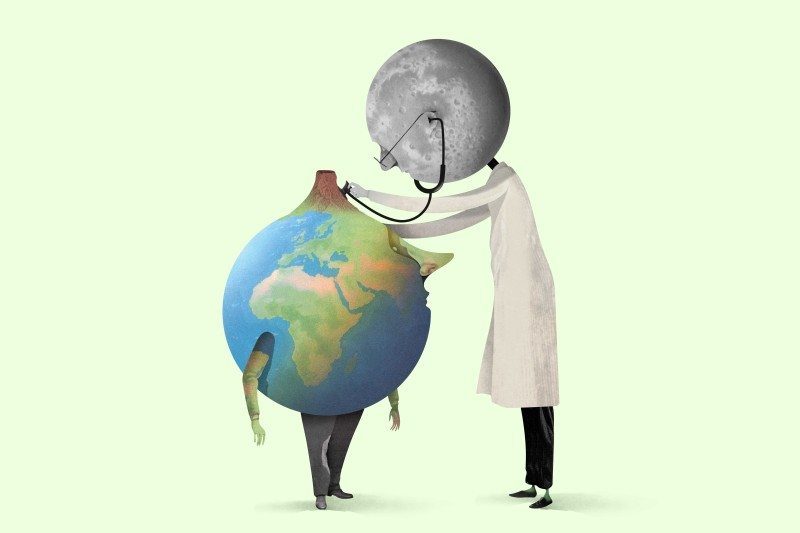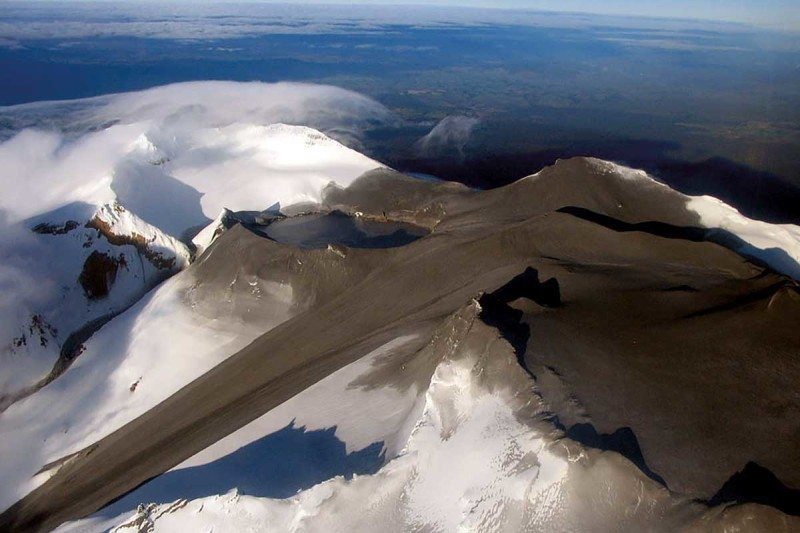
© Brett Ryder
Throughout history, people have suspected the moon of messing around with life on Earth's surface. From inducing madness to affecting the growth of plants, most of these connections are as tenacious as they are ill-substantiated. But one area where the moon's influence cannot be disputed is on the seashore. Long before Isaac Newton's theory of gravity provided a physical explanation,
the link between the tides and the phases of the moon was obvious to anyone with an eye for patterns.And if the moon has such a strong effect on liquid water, well then, why shouldn't the ground be equally affected? Philosophers as far back as Pliny the Elder have speculated that the moon's movements across the sky might also be responsible for earthquakes and volcanic eruptions. Statisticians fought over the significance of the connection in the 19th century, and geophysicists of the 1970s and 80s kept the claim alive until lack of evidence finally pushed it out of the mainstream.
The current state of the field can best be summed up by an eye-catching paper published in January by Susan Hough. A seismologist with the United States Geological Survey, she had set out to answer an age-old question: does the timing of powerful earthquakes coincide with the phases of the moon? The abstract ran to one word:
No.
Most experts would agree that the blame for natural disasters like earthquakes and volcanic blasts lies elsewhere. But
even if tidal forces don't have the necessary power to cause eruptions, that doesn't mean their effects should be ignored. In fact, new research suggests that some volcanoes are more sensitive to the moon's pull than we thought. This knowledge could help us predict when they are gearing up for the most catastrophic kinds of eruption, giving us vital early warnings that could save lives. What's more, some researchers are hopeful that such effects could give us some heads up before those even more unpredictable and deadly earthly rumbles:
earthquakes.
Most of the volcanic and seismic activity on Earth occurs around the boundaries of tectonic plates, where the immense pressures and temperatures inside the planet make themselves felt at the surface. For volcanoes, the oozing magma below can provide a host of early-warning signals:
increased ground deformation, higher concentrations of gases like sulphur dioxide or tiny changes in surface gravity or temperature.
But not all volcanic eruptions involve easily detectable pools of magma. Highly explosive "phreatic" eruptions occur when pockets of superheated, pressurised steam and gas form beneath a volcano, bursting out with little to no warning. "Phreatic eruptions have proven difficult to predict and can be deadly," says Matthew Pritchard of Cornell University in Ithaca, New York. He points to the
2014 eruption of Mount Ontake in Japan, which was the country's deadliest since 1926, killing 63 hikers. Although
phreatic eruptions represent only about 5 per cent of the 18,000-odd events recorded since 1900, they are some of the most lethal.
© GeoNet, 2007 (Global Volcanism Network Bulletin)Nobody saw Ruapehu’s 2007 eruption coming
On 25 September 2007, one such explosion shook Ruapehu, New Zealand's largest and most active volcano. Although it took no lives, the massive eruption of rock, steam and gas sent a plume of debris several kilometres skywards. For 7 minutes, a magnitude-2.9 earthquake shook the ground around the volcano, and two lahars - fast-moving slurries of mud and volcanic rocks - rushed down its slopes, injuring a 22-year-old climber sleeping in a nearby shelter. "It was an eruption that occurred very suddenly. There were no geophysical signals," says Társilo Girona, a geophysicist at NASA's Jet Propulsion Laboratory in California. "Understanding what happened in this eruption in Ruapehu is really important."
So in 2016, when Girona and his colleagues got their hands on 12 years of continuous seismic data from sensors near Ruapehu's crater, they immediately set about looking for patterns. What they found took them by surprise:
in the three months running up to the 2007 eruption, the ground vibrations recorded around the volcano appeared to fall into sync with the effects of the lunar cycle.
As the tidal pull of the moon and sun increased, in other words, so did the seismicity. Dark side of the moonThe results were puzzling.
Tidal forces cause volcanism elsewhere in our solar system - on Jupiter's moon Io, for example, which has to contend with the gravitational tugging of three large neighbouring moons, besides the gas giant itself. But there are good reasons to think such forces can't cause the same kind of volcanism on Earth. While the combined gravity of the sun and moon is powerful enough to move water on our planet's surface, it is far too small to break solid rock in the way required to generate an eruption from scratch. "The tidal stresses are three orders of magnitude smaller than the pressure needed to trigger an eruption," says Girona.
Nonetheless,
the results were clear.
From a statistical perspective, the chances of the same results being observed by chance were one in 3.5 million. In other areas of physics, this level of certainty is enough to announce the discovery of a new particle. But what was going on in Ruapehu?
Girona is quick to explain that his research wasn't intended to uncover a link between eruptions and tides. And for most of the period covered by the data, the vibrations his team studied were almost entirely unaffected by the phases of the moon. The one exception was the crucial few months prior to Ruapehu's 2007 eruption. "
This suggests that when the volcano is in a critical state, the seismicity is responding to the tidal forces - and we can use that, in principle, to detect when a volcano is in a critical state," he says.
In the immediate build-up to a phreatic eruption, hundreds of thousands of tonnes of steam get trapped in chambers below the volcano itself. And just as lakes are capable of displaying full-blown tides while your bathtub is not,
this vast body of gas becomes uniquely sensitive to the moon's pull.Michael Manga at the University of California, Berkeley, is intrigued by the finding. "Using increased sensitivity of volcanic earthquakes to small external forcing makes sense as a tool to probe whether a volcano is getting ready to erupt," he says.
Against the tide For Hough, however, the benchmark of Girona's success will be whether or not his results can be replicated before another eruption occurs. "It remains to be seen that the patterns identified at Ruapehu will have any predictive power," she says.
Girona's problem, however, may be finding enough volcanoes that have continuous seismic data monitoring. Only 35 per cent of volcanoes that have erupted since 1500 do, and very few make their data freely available online in the same way as at Ruapehu.
What's more, Girona is concerned that the effects that emerged so cleanly in his data may be more muted elsewhere, given the islands of New Zealand are already known to have some of the world's biggest ocean tides. "If there's any place in the world where tides can have an effect on volcanoes, I would expect it's New Zealand," he says. That's why the researchers are already eyeing up suitable volcanoes in Japan and Costa Rica, where they can double-check their findings in less tidally sensitive parts of the world.
Girona is not ploughing this furrow alone. Gianluca Sottili at the Sapienza University of Rome has studied the volcano
on the Italian island of Stromboli that has been in near-continuous eruption for thousands of years. His work showed that over a 17-month period in 2010-11,
the hourly number of explosions grew every 14 days or so, in line with the tidal maxima of the full and new moon. Similarly, the perennially active Mount Etna on nearby Sicily appears to show a connection between the deformation of its flank and the position of the moon. When a volcano is already in an eruptive state, says Sottili, its activity may well turn out to be modulated by tidal forces.
For Sottili, Girona's work on Ruapehu marks the first time a link has been shown between the lunar cycle and the behaviour of a volcano prior to eruption. "It represents an important step forward in our understanding of the interaction between tidal forcing and terrestrial volcanism," he says.
If his team can replicate the results on other volcanoes, Girona hopes to develop a user-friendly, real-time monitoring tool that volcano observatories across the world can use to identify critical states that precede eruptions. Although the precise moment of an eruption is impossible to know in advance, he hopes that such an early-warning system could at the very least save lives. "Looking for new signals preceding phreatic eruptions is very important work," says Pritchard.
But Girona is dreaming bigger. For him, the million-dollar question is whether the pull of the moon might have a similarly small but measurable effect on tectonic plates - and could therefore be used to predict earthquakes as well as volcanic blasts.
The way to test this would be to see if highly stressed tectonic plates might exhibit small changes to their overall patterns of seismicity under the pull of tidal forces. Along with team-member Corentin Caudron at Ghent University in Belgium, Girona says he is in the very early stages of looking at data to explore just such a question.
Given how much more difficult earthquakes are to predict than volcanoes, however, their conclusions will need to be watertight if they hope to convince their peers. "If time proves me wrong, I'll be the first to applaud," says Hough. "But I don't expect to be applauding any time soon."
Comment: Science is discovering there are multiple factors that contribute to the delicate balance of stability on Earth, a major aspect is the interaction between the bodies within our solar system, which recently been showing ominous signs of change:
- Last year's solar eclipse set off a wave in the upper atmosphere that was detected as far away as Brazil
- Not your imagination: New research shows the full moon does affect sleep
- Mystery of moon's magnetic field deepens
- Cosmic climate change: Is the cause of all this extreme weather to be found in outer space?
- Scientists predict upsurge in major earthquakes for 2018 due to slowdown in Earth's rotation
- Volcanoes are erupting all over the place right now. Scientists have figured out why: A minute slowdown in the planet's rotation
- Subtle second magnetic field surrounding Earth discovered
- Radon, slosh dynamics and Mount Etna's unrest
Also check out SOTT radio's: Behind the Headlines: Earth changes in an electric universe: Is climate change really man-made?